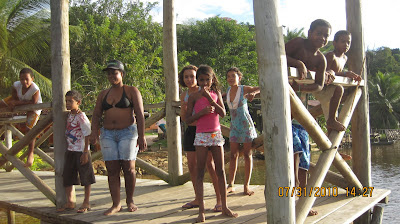 On Monday, (Aug 2) we visited the foremost cocoa research facility of Brazil - CEPLAC. Although Cocoa is native to parts of the Amazon, its successful introduction to Bahia meant that only a few plants were brought in and thus, plenty of space for improvement and research is needed. The fact that the Witches’ Broom disease devastated the state’s plantations makes it all the more important that solutions to recover this important commodity be found. So we visited the center's facilities following the complete production process, from planted tree to final chocolate bar/truffle of which we were able to have a taste!
On Monday, (Aug 2) we visited the foremost cocoa research facility of Brazil - CEPLAC. Although Cocoa is native to parts of the Amazon, its successful introduction to Bahia meant that only a few plants were brought in and thus, plenty of space for improvement and research is needed. The fact that the Witches’ Broom disease devastated the state’s plantations makes it all the more important that solutions to recover this important commodity be found. So we visited the center's facilities following the complete production process, from planted tree to final chocolate bar/truffle of which we were able to have a taste! |
| Sloth male, with its adopted baby |
Our visit began in the tree sloth conservation area where these curious, teethless treehuggers are brought in for recovery and release. They are native to the same area where cocoa plantations, are found - the Atlantic Rain Forest, an ecosystem of which only 7% remains. Our group had the chance to see them in action in the early morning when they are playing, swinging about and 'combing' their fur coats and long dark manes.
 |
| Marissa tickles a new friend |
Sloths are curious animals, and one of the younger 3-toed sloths came up to chat with us... He was very surprised to be tickled on the tummy!
 |
| cocoa beans drying in Bahia morning sun |
We then visited CEPLAC's farm and production area. cocoa 'barges' - a system of rolling sheds over suspended wooden flooring is a crucial part of the post-harvest. The cocoa beans are raked evenly in rows allowing for plenty of ventilation and exposure to sunlight so that they can dry after the fermentation in large wooden vats. As rain falls (2,000 - 2,500 mm /year) regularly almost every afternoon, the sheds are rolled over the beans every day to protect the harvest from excessive moisture and fungal attack.
.
 |
| Marcelo, Yuri, Lucas and our Brazil Science visitors |
Once the beans have dried they they are removed from the barges and taken into a building where they are weighed and stored in rucksack bags - 60 kg each. They are then ready to be shipped to markets world-wide.
 |
| from left to right all phases of chocolate manufacturing |
CEPLAC has a mini-chocolate factory. There, dried beans are initially processed by mild roasting (121 C). Other steps include removing the bean's shell, separating shells from beans, breaking the beans, making a base chocolate paste with 6% maximum of moisture, and removing cocoa 'butter' from the extract. Once the chocolate base is ready, it can be mixed with other components including sugar, milk and others to make delicious chocolates of all sorts. Cocoa butter is used in cosmetics, pharmaceuticals and for making white chocolate.
 |
| 2 large Anaconda skins and preserved snakes |
The Taxonomy lab holds a collection of over 5,000 specimens of insects, with representatives of over 1,000 different species, only a few of which are considered damaging to cocoa plantations. The labs' collection is mostly entomological (insects) although it also has specimens of all the snakes found in this area of tropical rainforests.
 |
| In center, Dr. Santana, CEPLAC's tropical soil specialist |
Our visit included CEPLAC's soils lab, where we heard Dr Sandoval Santana, a specialist in tropical soils explain to our group the main types of soils found in Bahia and their relative suitability for cocoa and other crops such as rubber, coconuts and sugar cane. Dr Sandoval explained the importance of knowing soils 'genetics' so they can be properly managed so as to avoid excessive erosion and degradation.
 |
| cocoa plant in 'tubettes' |
Finally, we entered one of the institute's many greenhouses where research on genetic manipulations result in improved varieties of cocoa plants, cloned and grafted. These are then distributed to farmers in partnership programs were the plants can be followed for performance and further manipulation.
 |
| cocoa clones recently grafted and ready for planting |

 ographed.
ographed. ographed.
ographed.


 None of our adventures would have been possible without the help of our brilliant Dr. Scott (you are not our burro) and his passion for topics such as the food chain, invasive species, predators, tools and our very favorite, the mangrove.
None of our adventures would have been possible without the help of our brilliant Dr. Scott (you are not our burro) and his passion for topics such as the food chain, invasive species, predators, tools and our very favorite, the mangrove. As for me, I feel more priveleged than ever to do the work that I do (despite the 27 bug bites on me & still itching, good times...) - What a joy to be with each of you!!!
As for me, I feel more priveleged than ever to do the work that I do (despite the 27 bug bites on me & still itching, good times...) - What a joy to be with each of you!!!












































